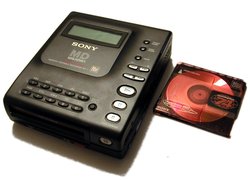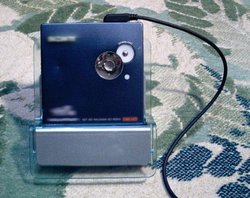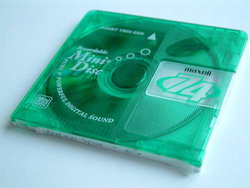MiniDisc
|
|
A MiniDisc (MD) is a disc-based data storage device for storing any kind of data, usually audio. The technology was announced by Sony in 1991 and introduced January 12 1992. Along with Philips' Digital Compact Cassette (DCC) system, MiniDisc was targeted as a replacement for analogue cassette tapes as the recording system for Hi-Fi equipment. What became a very brief format war ended when DCC was phased out in 1996.
MD Data, a version for storing computer data was announced by Sony in 1993, but it never gained significant ground, so today MDs are used primarily for audio storage.
Although MiniDisc has had some success, it has not caught on as well as Sony had hoped. The low initial uptake of the format was attributed to the small number of pre-recorded albums available on MD, which are only produced by Sony's own record labels and later were phased out completely, and high cost of equipment. The company avoided the mistake that it had made in the 1970s with the Betamax video recording system, and this time licensed the MD technology to other manufacturers, with JVC, Sharp, Pioneer, Panasonic and others all producing their own MD systems. In recent years MiniDisc has faced new competition from CD-Recordable, solid-state memory recording (MP3), and hard disk recording, while the popularity of traditional cassette tape refuses to wane in certain quarters.
| Contents |
Design
Physical characteristics
The disc is permanently housed in a cartridge (68 × 72 × 5 mm) with a sliding door, not unlike 3.5 in floppy diskettes. The audio discs can either be recordable (blank) or premastered. Recordable MiniDiscs use a magneto-optical system to record data. A laser heats one side of the disc to its Curie point, making the material in the disc susceptible to a magnetic field. A magnetic head on the other side of the disc alters the polarity of the heated area, recording the digital data onto the disk. Recordable MDs can be recorded on repeatedly; Sony claims up to one million times. As of May 2005, there are 60-, 74-, and 80-minute discs available.
Premastered MiniDiscs use a mastering process and optical playback system that is very similar to a CDs, making them physically dissimilar to recordable discs. The recorded signal of the premastered pits and of the recordable MD are very similar to that of the CD. Eight-to-Fourteen Modulation (EFM) and a modification of CD's CIRC code, called Advanced Cross Interleaved Reed-Solomon Code (ACIRC) are employed.
Differences to Competing Standards: Cassette, CD
Minidiscs use rewritable magneto-optical storage to store the data. Unlike the Digital Compact Cassette, or the (analogue) audio cassette, the disc is a random-access medium, making seeks very fast. At the beginning of the disc there is a table of contents (TOC), which stores the start positions of the various tracks, as well as meta information (Title, Artist) about them and free blocks. Unlike with the conventional cassette, a recorded song does not need to be stored as one piece on the disk, it can be stored in several fragments. Early minidisc equipment had a fragment granularity of 4 seconds audio. Fragments smaller than the granularity are not kept track of, which may lead to the usable capacity of a disc actually shrinking. Also, no means of defragmenting the disc are provided in consumer grade equipment. Defragmentation would require either two discs, or enough RAM to store the full contents of a minidisc, and computing power to rearrange the fragments so that each song is stored on the disc in one fragment only.
All consumer-grade Minidisc devices feature a copy-protection scheme known as Serial Copy Management System. An unprotected disc or song, can be copied without limit, but the copies can no longer be digitally copied.
Compression
The audio on a MiniDisc is compressed using the ATRAC format (Adaptive Transform Acoustic Coding) while a CD contains 16 bit linear PCM audio. ATRAC is similar to other compression formats in that data are discarded according to an algorithm that exploits certain psychoacoustic principles. The algorithm employed uses lossy compression, i.e. the decompression of the compressed signal will not yield the original signal. Due to limitations in human hearing and perception, some sounds cannot be heard under a variety of conditions, and these data can simply be thrown away without noticeable difference to the recording. Whilst the difference in sound quality could be easily spotted when MiniDisc appeared, today it is virtually impossible to tell, due to vast improvements in the ATRAC algorithm. The latest version of Sony's ATRAC is "ATRAC3plus" (Sharp and Panasonic have their own (but fully interoperable) ATRAC codecs).
Anti-skip
MiniDisc has an advantageous feature that prevents disc skipping. Older CD players had once been a source of annoyance to users as they were prone to mistracking due to vibration and shock. MiniDisc solved this problem by reading the data into a memory buffer at a higher speed than was required (the size of the buffer varies from model to model) before being read out to the digital-to-analogue converter at the standard rate required by the format. If the MiniDisc player was bumped, playback could continue unimpeded while the laser repositioned itself to continue reading data from the disc. If the memory buffer is sufficiently full, this feature allows the player to stop the spindle motor for long periods, increasing battery life. The memory buffer concept was incorporated shortly afterwards into portable CD players as well.
Note that a buffer of at least ten seconds is required on all MiniDisc players, be they portable or not. This is needed to ensure uninterrupted playback in the presence of fragmentation.
Operation
The data structure and operation of a MiniDisc is similar to that of a computer's hard disk drive. The bulk of the disc contains data pertaining to the music itself, and a small section contains the User Table of Contents, providing the playback device with vital information about the number and location of tracks on the disc. Tracks and discs can be named. Tracks may easily be added, erased, combined and divided, and their preferred order of playback modified. Erased tracks are not actually erased at the time, but are marked so. When a disc becomes full, the recorder can simply slot track data into sections where erased tracks reside. This can lead to some fragmentation but unless many erasures and replacements are performed, the only likely problem is excessive searching, reducing battery life.
Format extensions
MDLP
In 2000, Sony announced MDLP (MiniDisc Long Play), which added new recording modes based on a new codec called ATRAC3. In addition to the standard, near CD-quality mode, now called SP, MDLP adds LP2 mode, which allows twice as much recording time (160 minutes on an 80 minute disc) of good-quality stereo sound, and LP4, which allows four times more recording time (320 minutes on an 80 minute disc) of medium-quality stereo sound.
The bitrate of the standard SP mode is 292 kbit/s and it uses separate stereo coding with discrete left and right channels. For the vast majority of people the sound quality is indistinguishable from a CD. LP2 mode uses a bitrate of 132 kbit/s and also uses separate stereo coding. For most people the sound quality is almost as good as SP. The last mode, LP4 has a bitrate of 66 kbit/s and uses joint stereo coding. The sound quality is noticeably poorer than the first two modes, but is sufficient for many uses.
Tracks recorded in LP2 or LP4 mode play back as silence on non-MDLP players.
NetMD
NetMD recorders allow music files to be transferred from a computer to a recorder (but not in the other direction) at high speed over a USB connection. In LP4 mode, speeds of up to 32× real-time are possible and three Sony NetMD recorders: MZ-N10, MZ-N910, and MZ-920 are capable of speeds up to 64Χ real-time. NetMD recorders all support MDLP.
Hi-MD
Sonymznhf800.JPG
The latest extension to the Minidisc format is Hi-MD. Hi-MD players and recorders feature a new ATRAC3plus codec and have the ability to store files of any type on their discs. Hi-MD players work with three different types of discs:
- Conventional discs - Hi-MD devices have the same capabilities of NetMD and MDLP devices when working with these, but no more.
- Conventional discs reformatted to Hi-MD - These have a raw data capacity of around 320 MB, compared to around 180 MB for standard conventional discs.
- Hi-MD discs - These have the same form factor as conventional discs but a new recording medium gives a raw data capacity of approximately 1 GB.
The latter two disc types have the following new features and characteristics:
- A new ATRAC3plus codec, available in bitrates of 256 kbit/s, 64 kbit/s and 48 kbit/s, plus a Linear PCM recording mode.
- When connected to a computer, a Hi-MD formatted disc can be used to store computer files such as photos and text files.
- They cannot be read at all by non-Hi-MD devices.
In 2005 Sony presented an update to its Hi-MD devices: native support for the popular MP3 format. Unfortunately, this did not include drag-and-drop capability, but rather required the use of the Sony software to wrap the MP3 files in DRM.
A 1 GB Hi-MD disc can hold between 94 minutes (PCM) and 45 hours (48 kbit/s) of music.
Only analogue recordings and files the user has added to an HI-MD device can be uploaded from an HI-MD device to a computer.
External links
- Minidisc Community Portal (http://www.minidisc.org/)
- Minidisc.org FAQ (http://www.minidisc.org/minidisc_faq.html)
- Minidisc Forum (http://forums.minidisc.org)
- Linux and Sony MiniDisc players (http://tuxmobil.org/player_linux_survey_sony.html)de:MiniDisc
es:Minidisc eo:Minidisko ko:미니디스크 it:Minidisc nl:Minidisc ja:ミニディスク pl:Minidisc pt:MiniDisc fi:MiniDisc sv:Minidisc zh:MD



